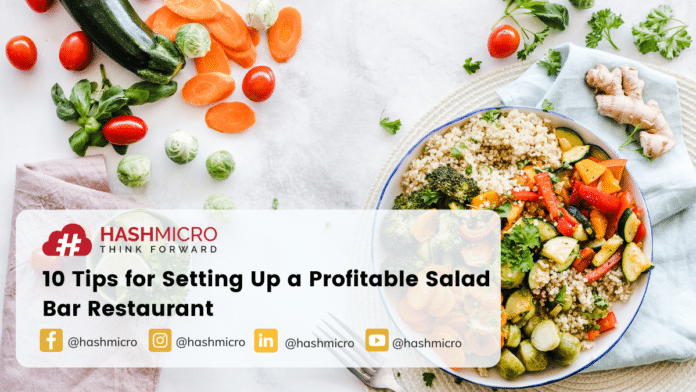The salad bar is one novel innovation in the culinary business that attracts businessmen in Singapore. The factor that contributes to it is that more people realize the importance of shaping a healthy life.
Previously, meat dominated the fast-food restaurant menu. Now, with the same concept of fast food, some innovative businessmen replace meat with vegetables and other rich-protein food as their main menu.
There are also a lot of fast food culinary processors that use F&B Software that can help increase sales to maintain customer retention. If you’re into this salad shop business, you are lucky to be reading this article. This article will discuss tips for setting up a salad bar with a maximum profit.
Key Takeaways
|
Table of Content:
Table of Content
Keep Your Food Fresh
A salad shop bar means that your customers will directly see the food that they are going to consume, be it vegetables or food with protein and carbohydrate sources.
It’s a fact that you and your customers want to have their food fresh. To achieve that, you need to make sure that you have adequate food stock. Therefore, the food inside the container will look full of fresh ones.
This step will help you to determine the price and the quality of the food. Moreover, your customers will have a good experience consuming your food. You can consider using an inventory management software that can optimize inventory levels, monitor stock transfers, estimate inventory requirements, and more.
Related article: 3 Vital Processes in Restaurant Inventory Management
Cut Your Vegetable
The size of the food matters. How often do you see your food cut largely? Are you interested in eating a whole red pepper or three broccoli florets in one cut?
Cutting your vegetable bite-sized will help you to get more products with the same amount of them. It decreases your overall food cost.
In addition, your customer will enjoy your food without having to cut their salad into pieces.
Use Small Utensil
It’s better to choose utensils such as tongs, ladles, and salad dressing bottles in a small size. It will allow your customer to take their food just in the right amount. Use a tong with a small gap on both tips, but not too small. You don’t want your customers to pick up the lettuce leaf by leaf.
So should the ladle. Usually, customers don’t only pick up one type of food. Therefore, use a small ladle so that they have a good proportion of each food item they pick. Lastly, the salad dressing bottle. Choose one with the smallest open tip so that you can control how much dressing they pour into their plate.
Use a Shallow Container
A shallow container will display fresher and more plenty of vegetables. If the container is too deep, there’s a possibility that the food won’t be used and left stale.
With a shallow container, you can:
-
- Ensuring food freshness
- Help food rotation
- Prevent stale vegetable
The thing you need to highlight is that this rule applies to every vegetable. Imagine if you stack plenty of mushrooms in a deep container. It will lose its freshness at the end of the day, you will dump it, and you will lose your money.
Rotate Your Product
Now let’s talk about food rotation.
Rotating your product does not mean changing the order of the food containers, but rather stirring the food within the container upwards.
Employees tend to panic when the product is about to run out. So, they just pour the new product on top of the old one. In most cases, the product on the bottom of the container is not picked up by customers and eventually will end up in the trash bag.
The solution is to remind your employees to put the newer product on the bottom of the container. Rotating the products like this will save you money, reduce food waste, and keep your food fresh.
Put the Cheapest Product in the Front
In our lives, most of us are trained to start everything from left to right. We read and write like that, and our eyes move from left to right when examining a work of art. We also tend to focus on the nearest things in front of us.
So, consider this behavior in your strategy. Put the cheapest product on the left and the front side of your bar. Therefore, your customer won’t pick too many products at a higher cost because their plate is almost full.
Read more: The Best 5 Restaurant Software in Indonesia
Change the Arrangement of Your Salad
Now, we’re talking about the order of your food container. You can switch from green olive to black olive occasionally. You can also put your seasonal salad bar menu on the front side of your bar. Do the same thing with your best-selling product.
If there’s a product that is about to run out, you can move it to the middle so that customers won’t take too much of it.
Create an Attractive Display

An attractive display does not only mean a sophisticated interior design with automatic kitchen management. It means that you have to give various types of vegetables in different colors.
People don’t expect to see lettuce, corn, tomatoes, or other common vegetables as their option. You can give them more vegetables and a wide range of carbohydrates, protein, and salad dressing. Therefore, your salad shop bar will look more attractive or even become the best salad in Singapore!
If Possible, Choose Organic Vegetable
Despite the high cost of organic vegetables, it does not stop people from consuming them. Other than it being healthier, the issue of climate change, which pesticide contributes to it, is the reason why people prefer organic vegetables.
Moreover, people will be more attracted if they know the vegetable is from the local farmer. Hence, you can promote your salad shop as a food of “natural”, “no pesticides”, and “hormone-free”.
Practice Good Hygiene
E. coli haunts people who want to eat raw vegetables. So, you need to make sure that you clean your vegetables thoroughly and follow the procedure of hygiene in your area.

Conclusion
I hope that the 10 tips above are useful for setting up your salad bar. Of course, you need to experiment to find the best strategy to increase your profit. You can also consider using restaurant POS software that can automate your restaurant management, including inventory issues which is an important aspect of your product’s fresh food.
In addition, this software can also help manage transactions, set tables, and monitor kitchen orders. If you want to get a free demo of our tour product, click here!



































